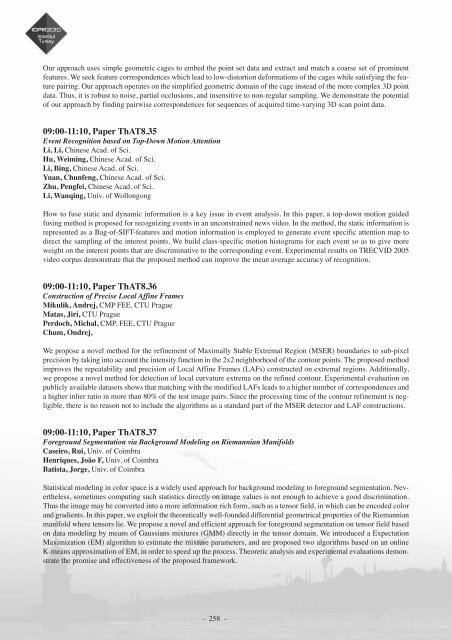Abstract book (pdf) - ICPR 2010
Abstract book (pdf) - ICPR 2010
Abstract book (pdf) - ICPR 2010
- TAGS
- abstract
- icpr
- icpr2010.org
You also want an ePaper? Increase the reach of your titles
YUMPU automatically turns print PDFs into web optimized ePapers that Google loves.
Our approach uses simple geometric cages to embed the point set data and extract and match a coarse set of prominent<br />
features. We seek feature correspondences which lead to low-distortion deformations of the cages while satisfying the feature<br />
pairing. Our approach operates on the simplified geometric domain of the cage instead of the more complex 3D point<br />
data. Thus, it is robust to noise, partial occlusions, and insensitive to non-regular sampling. We demonstrate the potential<br />
of our approach by finding pairwise correspondences for sequences of acquired time-varying 3D scan point data.<br />
09:00-11:10, Paper ThAT8.35<br />
Event Recognition based on Top-Down Motion Attention<br />
Li, Li, Chinese Acad. of Sci.<br />
Hu, Weiming, Chinese Acad. of Sci.<br />
Li, Bing, Chinese Acad. of Sci.<br />
Yuan, Chunfeng, Chinese Acad. of Sci.<br />
Zhu, Pengfei, Chinese Acad. of Sci.<br />
Li, Wanqing, Univ. of Wollongong<br />
How to fuse static and dynamic information is a key issue in event analysis. In this paper, a top-down motion guided<br />
fusing method is proposed for recognizing events in an unconstrained news video. In the method, the static information is<br />
represented as a Bag-of-SIFT-features and motion information is employed to generate event specific attention map to<br />
direct the sampling of the interest points. We build class-specific motion histograms for each event so as to give more<br />
weight on the interest points that are discriminative to the corresponding event. Experimental results on TRECVID 2005<br />
video corpus demonstrate that the proposed method can improve the mean average accuracy of recognition.<br />
09:00-11:10, Paper ThAT8.36<br />
Construction of Precise Local Affine Frames<br />
Mikulik, Andrej, CMP FEE, CTU Prague<br />
Matas, Jiri, CTU Prague<br />
Perdoch, Michal, CMP, FEE, CTU Prague<br />
Chum, Ondrej,<br />
We propose a novel method for the refinement of Maximally Stable Extremal Region (MSER) boundaries to sub-pixel<br />
precision by taking into account the intensity function in the 2x2 neighborhood of the contour points. The proposed method<br />
improves the repeatability and precision of Local Affine Frames (LAFs) constructed on extremal regions. Additionally,<br />
we propose a novel method for detection of local curvature extrema on the refined contour. Experimental evaluation on<br />
publicly available datasets shows that matching with the modified LAFs leads to a higher number of correspondences and<br />
a higher inlier ratio in more than 80% of the test image pairs. Since the processing time of the contour refinement is negligible,<br />
there is no reason not to include the algorithms as a standard part of the MSER detector and LAF constructions.<br />
09:00-11:10, Paper ThAT8.37<br />
Foreground Segmentation via Background Modeling on Riemannian Manifolds<br />
Caseiro, Rui, Univ. of Coimbra<br />
Henriques, João F, Univ. of Coimbra<br />
Batista, Jorge, Univ. of Coimbra<br />
Statistical modeling in color space is a widely used approach for background modeling to foreground segmentation. Nevertheless,<br />
sometimes computing such statistics directly on image values is not enough to achieve a good discrimination.<br />
Thus the image may be converted into a more information rich form, such as a tensor field, in which can be encoded color<br />
and gradients. In this paper, we exploit the theoretically well-founded differential geometrical properties of the Riemannian<br />
manifold where tensors lie. We propose a novel and efficient approach for foreground segmentation on tensor field based<br />
on data modeling by means of Gaussians mixtures (GMM) directly in the tensor domain. We introduced a Expectation<br />
Maximization (EM) algorithm to estimate the mixture parameters, and are proposed two algorithms based on an online<br />
K-means approximation of EM, in order to speed up the process. Theoretic analysis and experimental evaluations demonstrate<br />
the promise and effectiveness of the proposed framework.<br />
- 258 -



